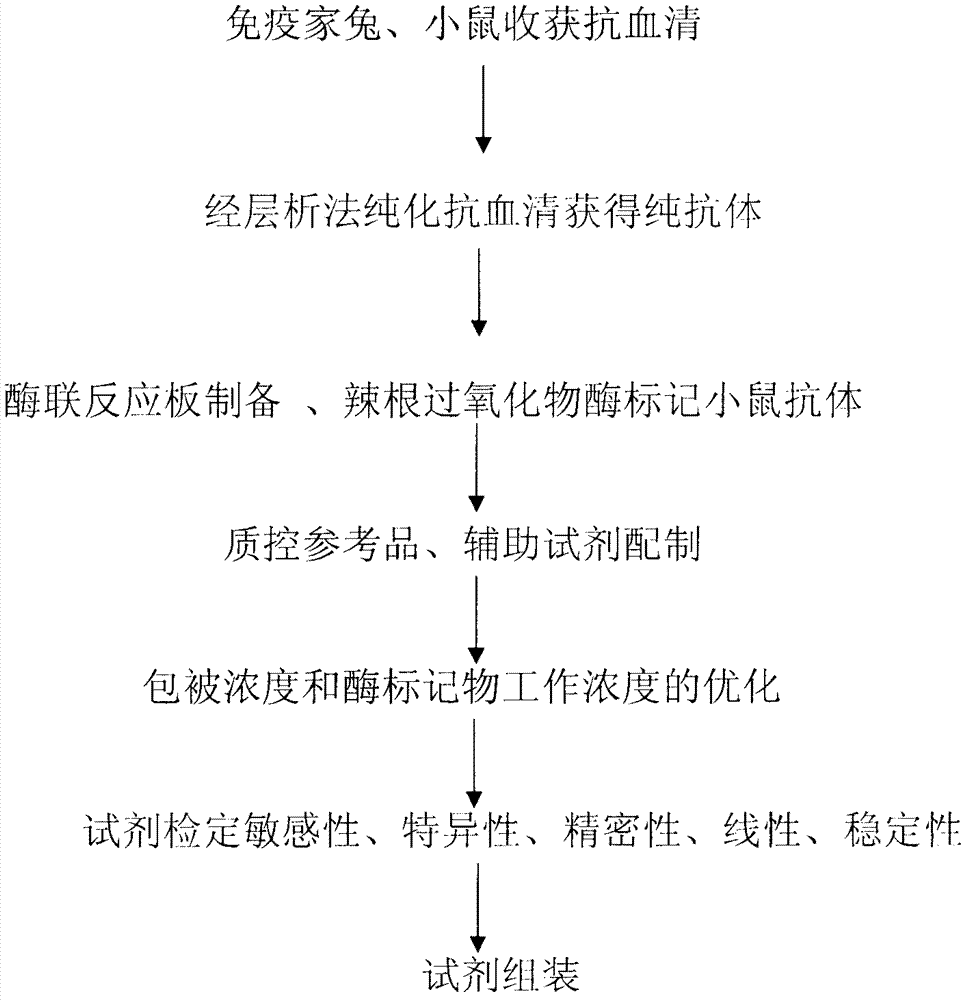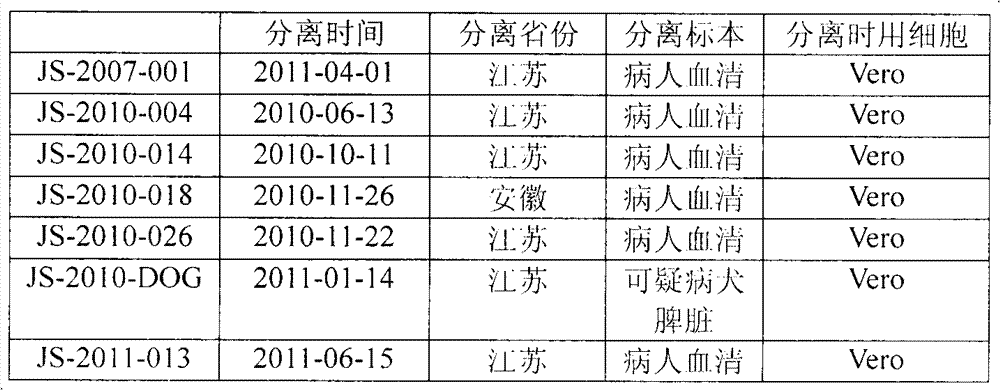Preparation and application of an ELISA kit for detecting neobunia virus antigen
A new bunya virus, virus antigen technology, applied in the direction of biological testing, measuring devices, material inspection products, etc.
- Summary
- Abstract
- Description
- Claims
- Application Information
AI Technical Summary
Problems solved by technology
Method used
Image
Examples
Embodiment 1
[0017] Embodiment 1: New bunya virus (JS-2007-001 virus strain) immunization rabbit and serum antibody preparation
[0018] Seven New Bunia virus strains were isolated from Jiangsu and Anhui epidemic areas, 6 strains were directly isolated from patient serum, and 1 strain was from a suspected sick dog. All cells were VERO cells when isolated (Table 1).
[0019] Table 1: Isolation time and source of 7 New Bunyavirus strains
[0020]
[0021] Adaptive culture, immunogenicity identification and immunoprotection identification of 7 New Bunia virus strains in VERO cells found that the JS-2007-001 virus strain has the best growth characteristics and adaptability characteristics. When the growth peak is reached, a higher titer virus can be obtained stably, and the antibody level of the immunized animals is higher. The immune serum neutralization test found that it has a good protective effect on all 7 strains of the virus. So choose the JS-2007-001 virus seed as the prepared vir...
Embodiment 2
[0025] Example 2: New Bunia virus (JS-2007-001 strain) immunization of mice and serum antibody preparation and HRP labeling
[0026] Dilute the purified and inactivated New Bunyavirus antigen with normal saline in an appropriate amount at 0.1-200 μg / mL, add Freund's complete adjuvant (Sigma) for mixing, select 15-25 g mice, and then Inject 1 to 5 mg of BCG in the legs for sensitization. Two weeks later, the mice were intraperitoneally injected with the above-mentioned adjuvant antigen, and boosted with the same dose of different immunized parts at an interval of 2 to 4 weeks. A total of 3 to 5 immunizations were performed. The mouse serum was collected 10 days after the last immunization for antibody For titer determination, whole blood was collected after reaching a ratio greater than 1:20000, and serum was routinely separated. Pure antibody was purified by Protein G conventional method.
[0027] Preparation of HRP-labeled mouse anti-New Bunia virus antibody. The antibody ...
Embodiment 3
[0028] Example 3: Antibody-coated plate preparation.
[0029]The purified antibody was appropriately diluted (1-10 μg / mL) with 0.05M pH 9 carbonate coating buffer. Add the diluted antibody liquid into the wells of the enzyme-linked plate, 100 μL per well, and coat at 4°C for 18-20 hours, discard the liquid in the wells, wash the plate several times, and add enzyme stabilizer (Shandong, Taitianhe Biotech) In each well of the plate, 150-200 μL per well. React at 4°C for 4-6 hours. Discard the protective agent in the well, dry the coated plate by freeze-drying method, seal the enzyme-linked plate and store it at 2-8°C for later use.
PUM
| Property | Measurement | Unit |
|---|---|---|
| Sensitivity | aaaaa | aaaaa |
| Sensitivity | aaaaa | aaaaa |
Abstract
Description
Claims
Application Information
 Login to View More
Login to View More - R&D
- Intellectual Property
- Life Sciences
- Materials
- Tech Scout
- Unparalleled Data Quality
- Higher Quality Content
- 60% Fewer Hallucinations
Browse by: Latest US Patents, China's latest patents, Technical Efficacy Thesaurus, Application Domain, Technology Topic, Popular Technical Reports.
© 2025 PatSnap. All rights reserved.Legal|Privacy policy|Modern Slavery Act Transparency Statement|Sitemap|About US| Contact US: help@patsnap.com



